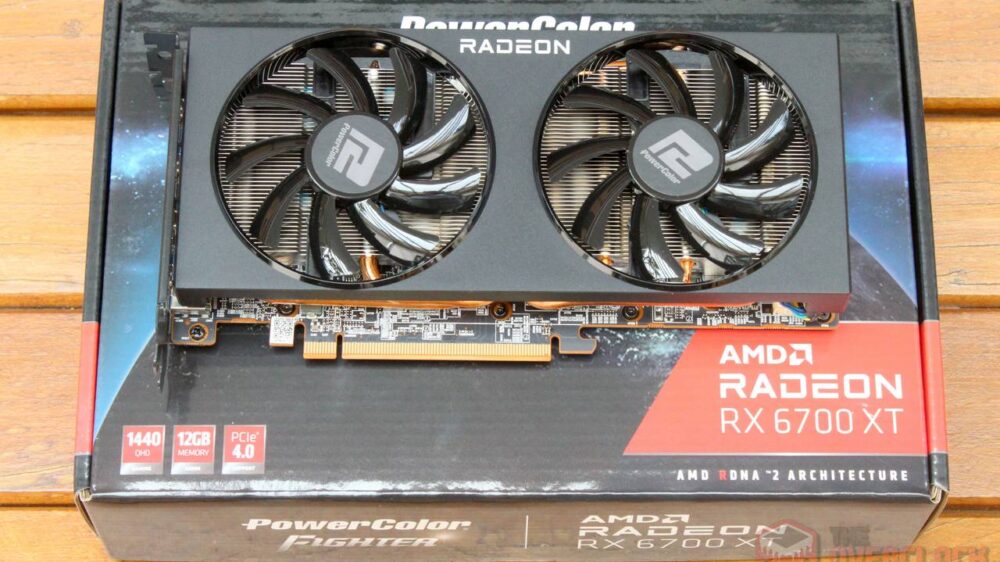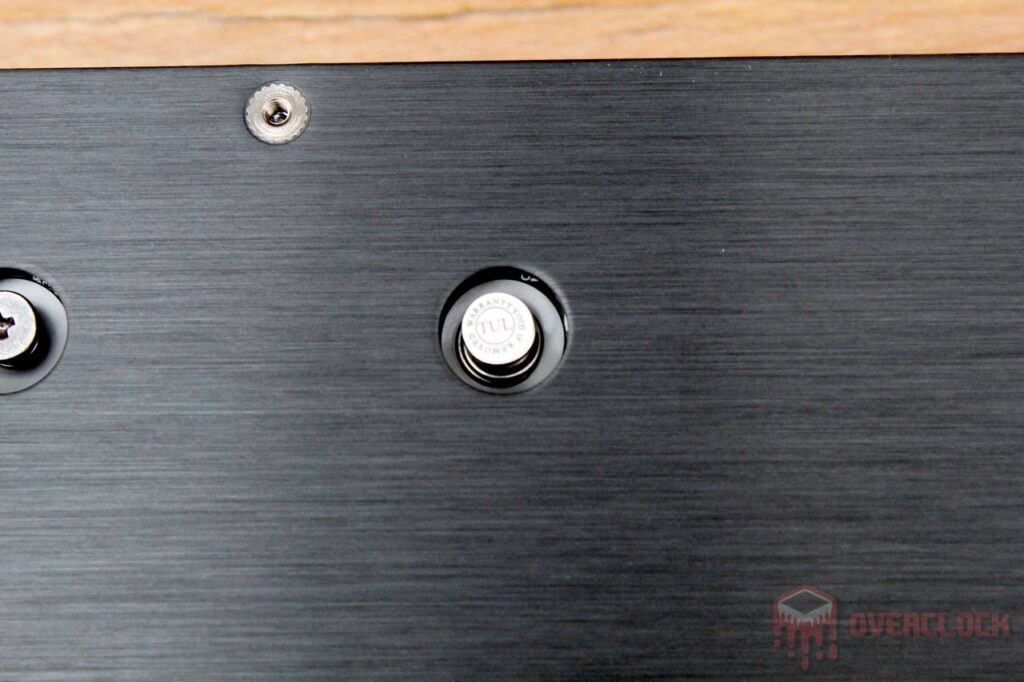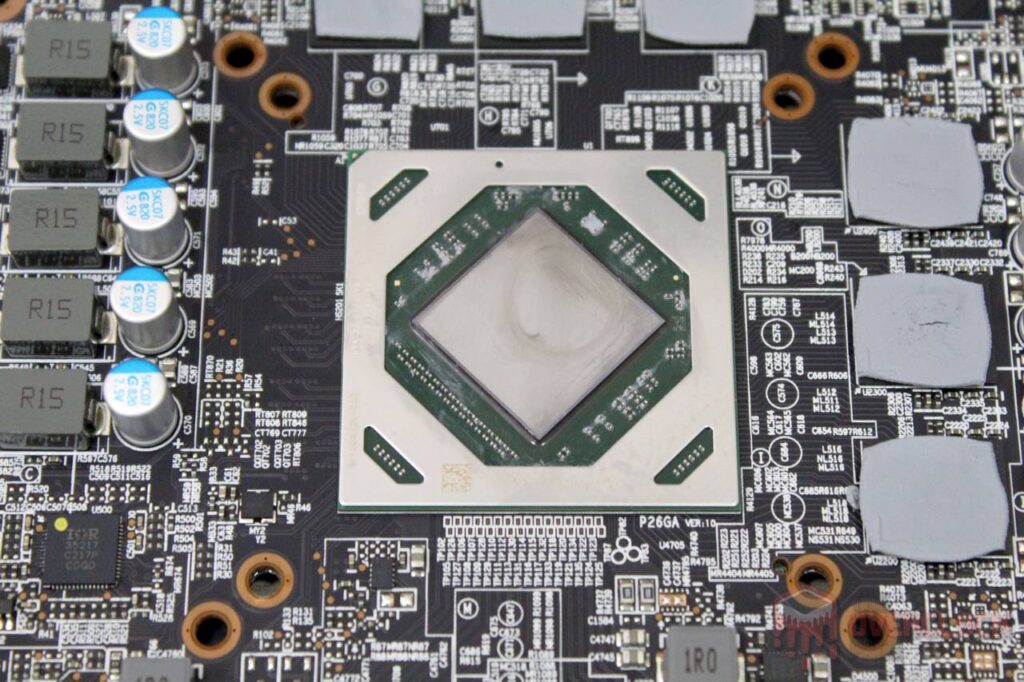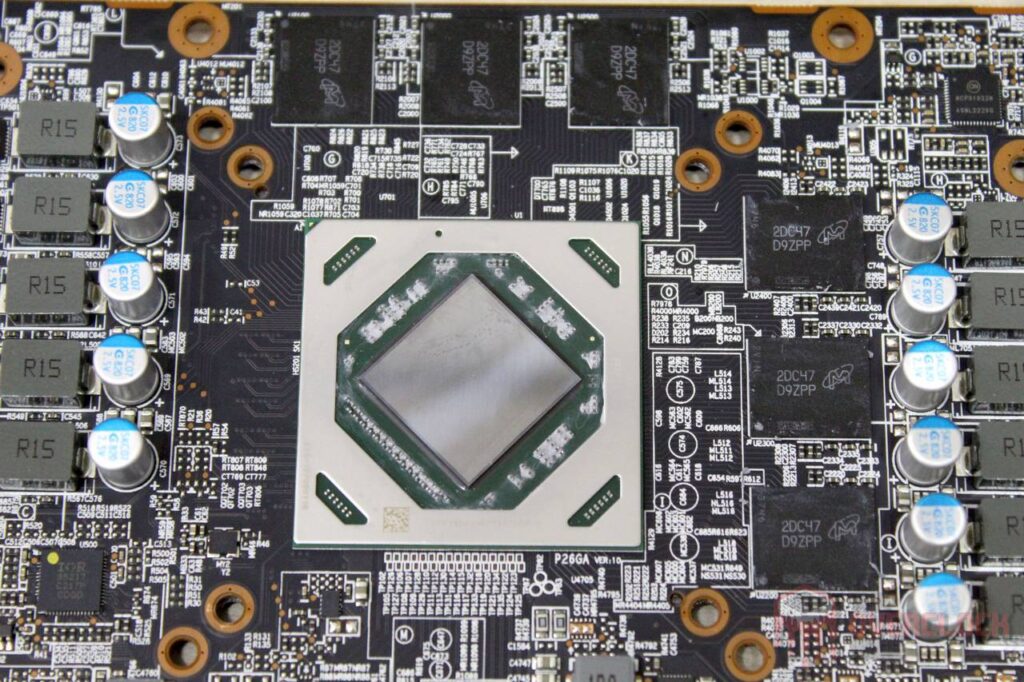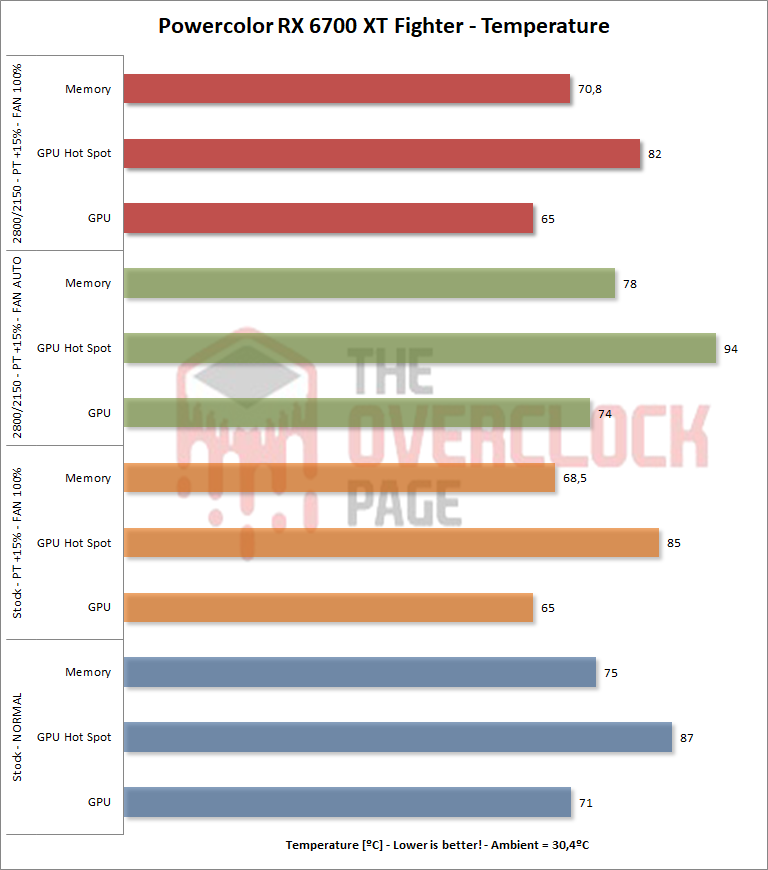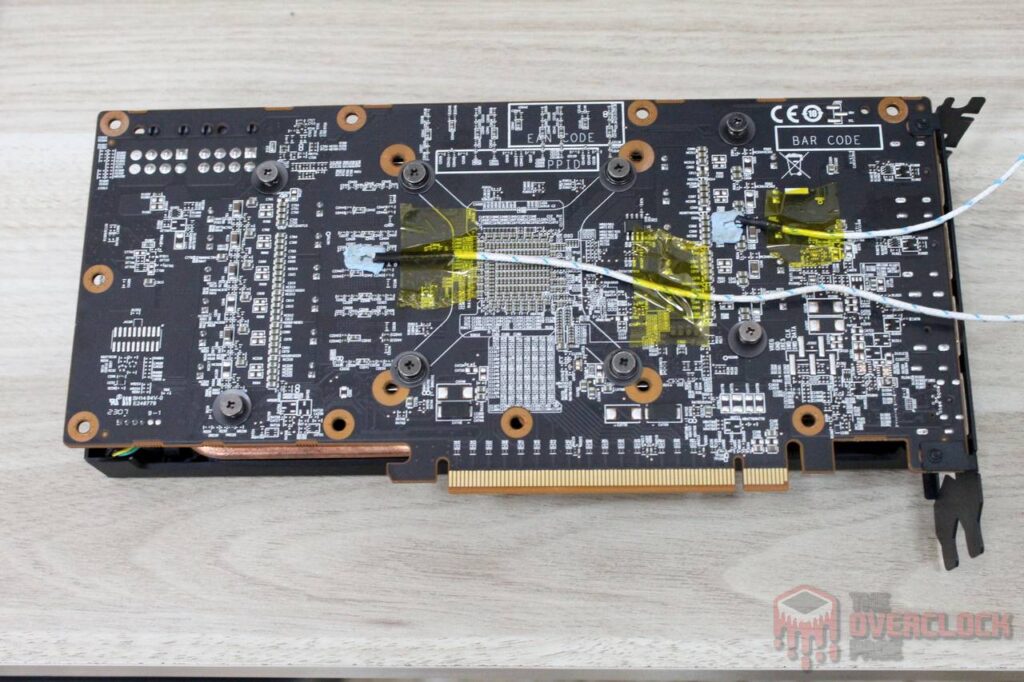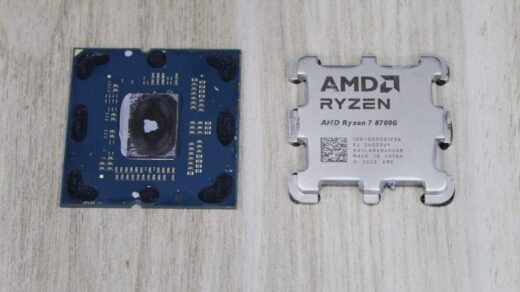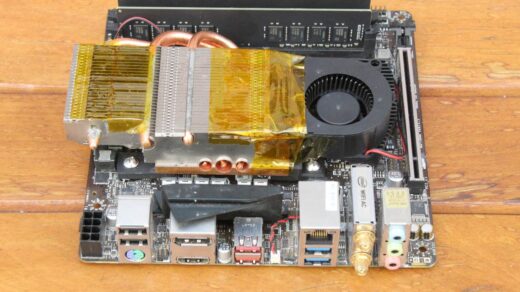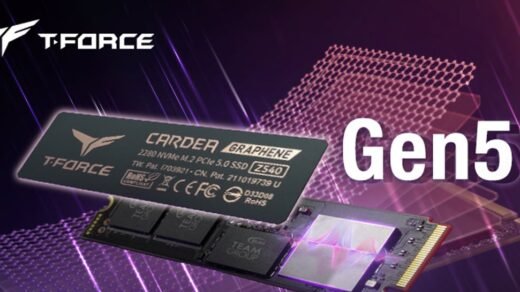Review – Powercolor RX 6700 XT Fighter: Compact yet powerful Graphics Card!
In this review, I will analyze the Powercolor RX 6700 XT Fighter, which is a mid-range model from AMD’s RX 6000 series, utilizing the RDNA2 architecture and manufactured on the 7nm process. Despite being a more straightforward variant of the RX 6700 XT, it boasts a noteworthy feature — a dual-fan and dual-slot cooler. This sets it apart as a compelling choice for Small Form Factor (SFF) systems and compact cases. But, is this truly a commendable graphics card? Let’s delve into that question in this review.
On the packaging, the front of the box prominently features the “Fighter” series, the card model, and its 12GB of VRAM. On the rear side, additional details are provided regarding the cooling system and various specifications of this GPU.


The cooler employed is a 2-slot unit with two ~90mm fans, lacking RGB illumination. The card’s length is approximately 230mm, posing no issues for ITX cases like the Sugo SG-13 and similar models.
In contrast to the reference 6700 XT with a 230W TDP, Powercolor chose to decrease this figure to 185W for the Fighter, affecting power consumption, heat dissipation, and performance. In the upcoming tests, we’ll explore the impact of this decision on the card and evaluate how well the cooling system handles these adjustments.
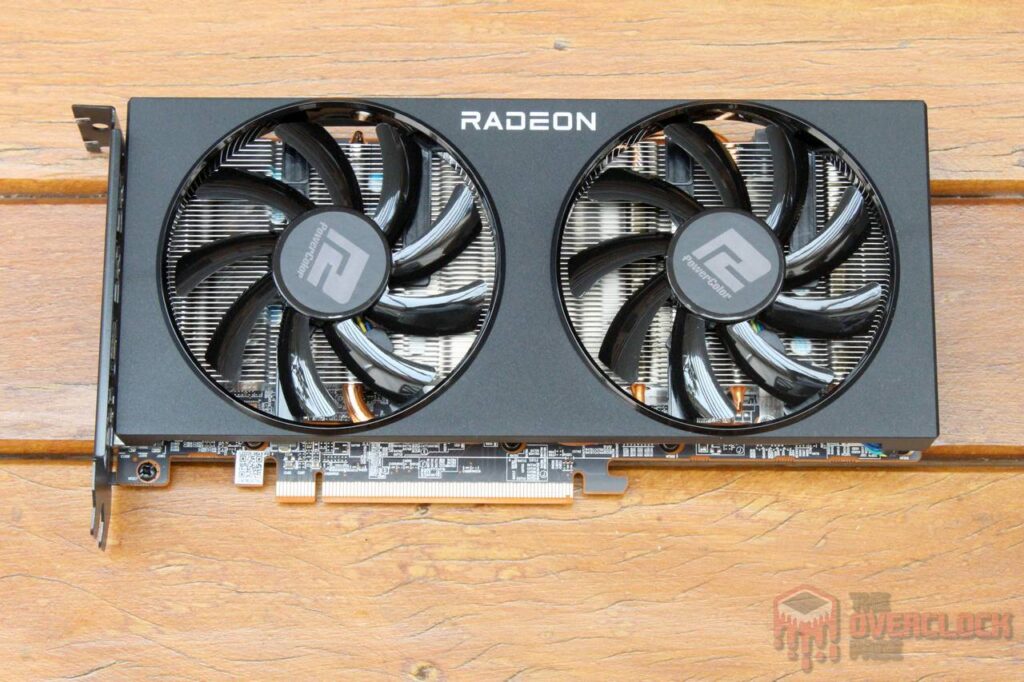
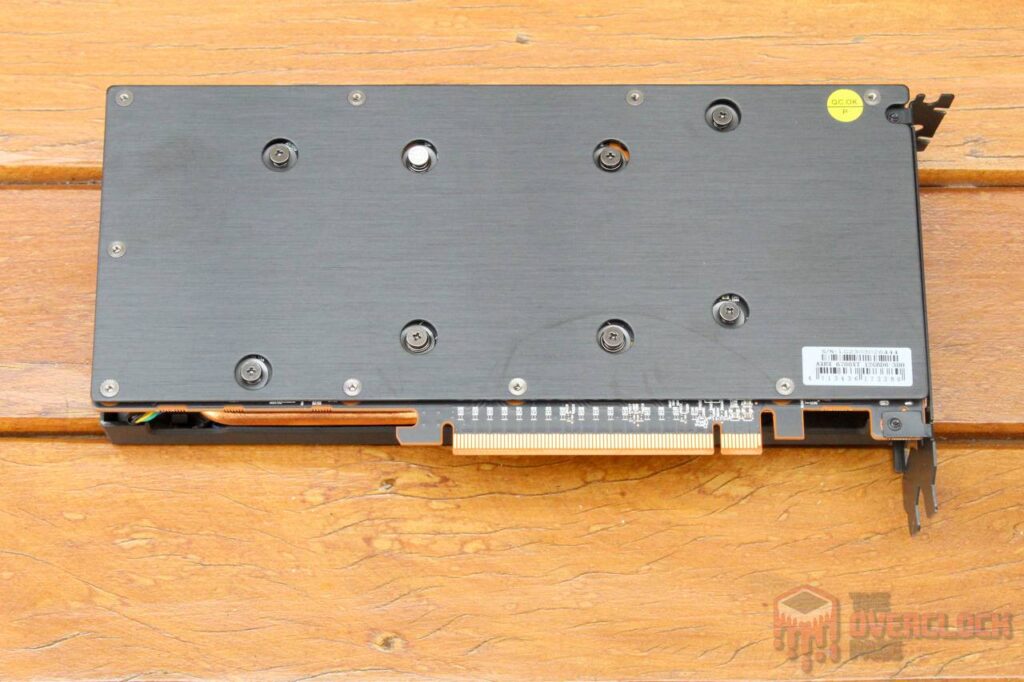

On the rear bracket, Powercolor has opted for 3x DisplayPort and 1x HDMI, aligning with expectations for a modern graphics card.
Regarding the warranty, unfortunately, Powercolor has chosen to include the “notorious” seal on the card’s screw, which can be a concern for those looking to disassemble it for cleaning/maintenance or to install a water block within the warranty period. As reported, the warranty duration is one year.
Concerning the heatsink design, the manufacturer has chosen a configuration with three heat pipes and a copper base that makes contact with the GPU, coupled with aluminum components for the memory/VRM. In the case of the latter, “thermal pads” have been utilized as the thermal interface.
As for the backplate, it is made of metal and lacks thermal pads, serving a purely aesthetic purpose and providing additional rigidity to the card.
Regarding the PCB, it shares the same length as the card. On the front side, the Navi 22 GPU is visible alongside six GDDR6 memory chips, a nine-phase VRM for the GPU (including two for VDD_SOC), two phases for the memory, and the power connectors of eight and six pins. On the back side, just behind the graphics chip, there are capacitors responsible for filtering the power voltage.


Regarding the Navi 22 GPU, it is manufactured by TSMC using a 7nm process, featuring just over 17 billion transistors within an area of 335 mm². The variant employed in the 6700 XT has all its functional units activated, equating to 40 Compute Units, 160 TMUs, 64 ROPs, and 96 MB of L3 cache.
The GDDR6 memory chips used are Micron MT61K512M32KPA-16:C, with the code ‘D9ZPP’ and a density of 16 Gb. Six of these chips are employed on a 192-bit bus, resulting in a total memory capacity of 12 GB.
Concerning the card’s VRM, there are 7 phases dedicated to the GPU, and the IR35217 controller is adopted. Regarding the power stage, Powercolor has chosen to implement OnSemi-manufactured Powerstages, specifically the NCP302155, with a maximum current rating of 55A.
With a switching frequency of 500 KHz and a load of 155A (equivalent to the GPU at stock frequency), the VRM heat dissipation should be around 14W. Meanwhile, at 180A (representative of overclocking with maximum “Power Target”), the dissipated power is expected to be around 17.5W, which should not pose an issue for the employed thermal solution.
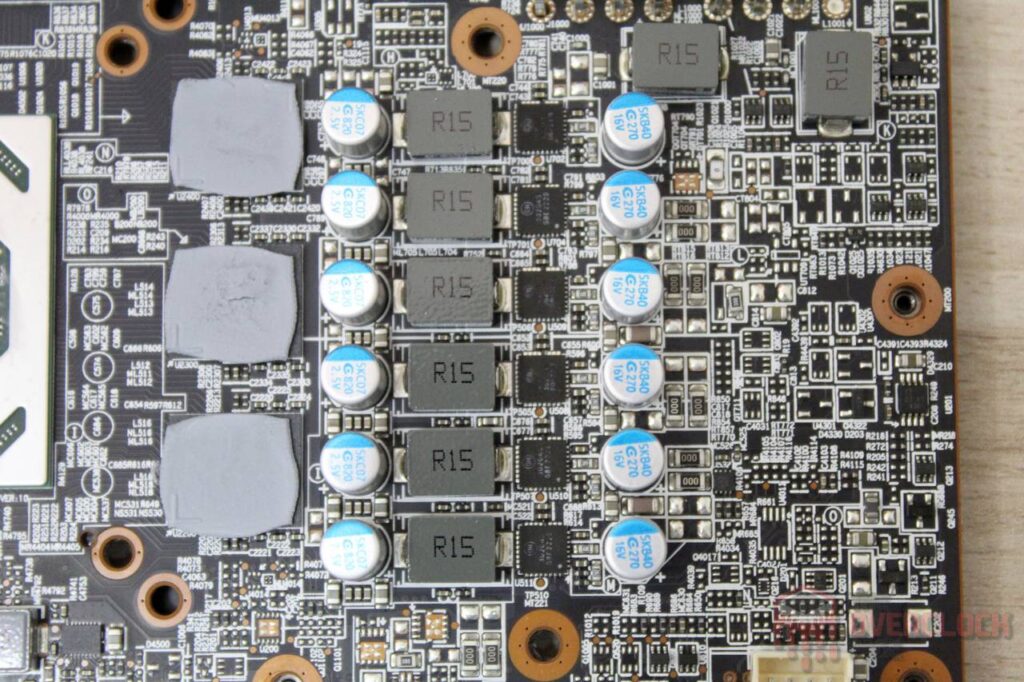
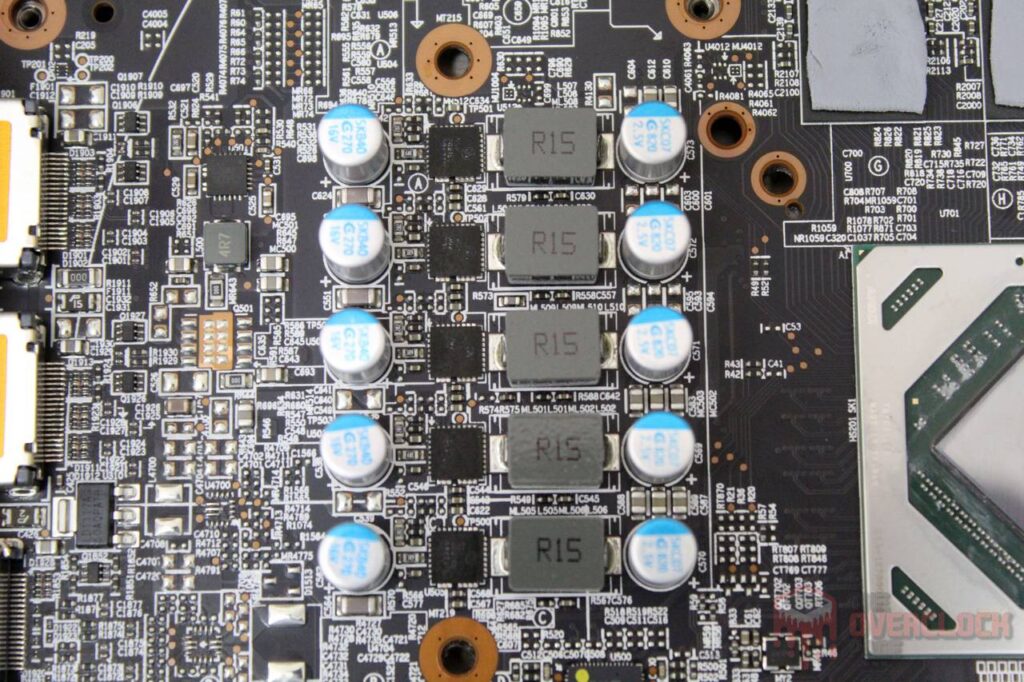
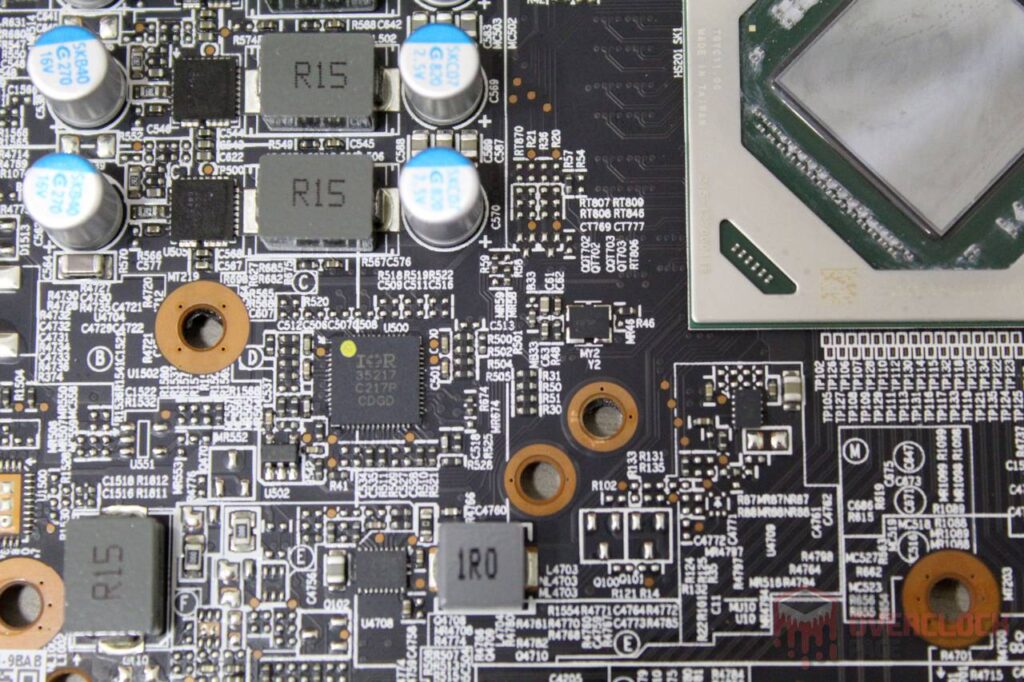
Hardware used:
CPU: AMD Ryzen 7 7700X (Thanks AMD!)
MOBO: GIGABYTE B650M Aorus Elite AX
RAM: 2x16GB Kingbank DDR5 6800 (Hynix A-Die)
VGA: Powercolor RX 6700 XT Fighter
STORAGE: SSD Goldenfir 256 GB + Kingston UV500 960 GB
PSU: Coolermaster MWE Gold 1250 V2 Full Modular (Thanks Cooler Master!)
SOFTWARE: Windows 11 (Adrenalin 23.10.2), GPU-Z 2.54.0, 3DMark, Unigine Superposition, UL Procyon, Shadow of Tomb Raider, Cyberpunk 2077, Far Cry 6 e Horizon Zero Dawn.
EXTRA: ElmorLabs KTH.
Objective of the tests:
Evaluate how the Powercolor RX 6700 XT Fighter performs with its standard cooling solution, assess its performance in select games, and finally, analyze its results in competitive benchmarks. Explanations regarding the adopted methodology or how the tests were conducted are provided in the accompanying texts alongside the results that follow.
Results:
Firstly, let’s examine how the Powercolor cooling system performs. To conduct these tests, the Unigine Superposition benchmark at the “4K Optimized” preset was used. This benchmark has a sufficiently long duration (around 3 minutes) and effectively simulates a load representing real-world GPU usage. In other words, it’s not a “power virus” like Furmark that stresses the GPU to unrealistic levels and induces throttling through driver commands. For these results, the driver settings were kept at default, and the Ryzen 7 7700X was running at stock with memory set to 8000 MT/s 38-46-46-42-40.
Temperature:
In the graph below, we present the results obtained for different clock and fan rotation configurations. The ambient temperature during the tests was 30.4ºC, a crucial piece of information for result interpretation and for those seeking an understanding of temperature differentials.
The tests were conducted with the card completely stock, stock with the fan at 100%, PT +15% (Power Target increased by 15%), overclock with auto fan and PT +15%, which is the maximum for this model, and finally, overclock with the fan at 100%.
An important note is that the “Hot Spot” on AMD GPUs is the highest temperature reading among a network with 64 or more sensors located at key points on the die, with a maximum limit of 115?°C. This temperature is particularly useful for identifying issues in the contact between the heatsink base and the die, often caused by poor thermal paste application.
Additionally, it’s crucial to emphasize that these tests were all conducted on a test bench, and the “ambient” temperature within a case tends to be higher than the actual ambient temperature. This is an essential detail for anyone attempting to replicate the presented results.
From the results presented above, it is evident that the original cooling solution of the card was able to deliver acceptable performance in any of the tested scenarios, showing, in the worst-case scenario, 74°C for the GPU and 94°C for the Hot Spot—impressive figures for an ambient temperature of 30.4°C and a tolerable noise level.
To validate the temperatures of the memory and VRM, a thermocouple with adhesive thermal pads was used on the backside of the PCB. To achieve this, the backplate of the card was removed. In both cases, temperatures were captured during the final loop of Unigine Superposition with the card under the “worst-case tested with overclock” condition, which was with auto fan and overclock. The ambient temperature at the time of these tests was 30.8°C.
With the card operating under these conditions, a maximum of 68.4°C was recorded for the VRM, and 67°C for the memory, showcasing exceptional results that certainly do not pose long-term issues for the components used.
The temperature registered for the memory is lower than the software reading, as expected, since the software reports the junction temperature, and this measurement is taken on the backside of the chip. Nevertheless, all remains well; the maximum reported junction temperature was 78°C, well below the 95°C limit for these chips.
Temperature/Frequency:
In the gallery below, it’s possible to observe a detailed analysis of the card’s performance in terms of clocks and temperatures throughout the benchmark:
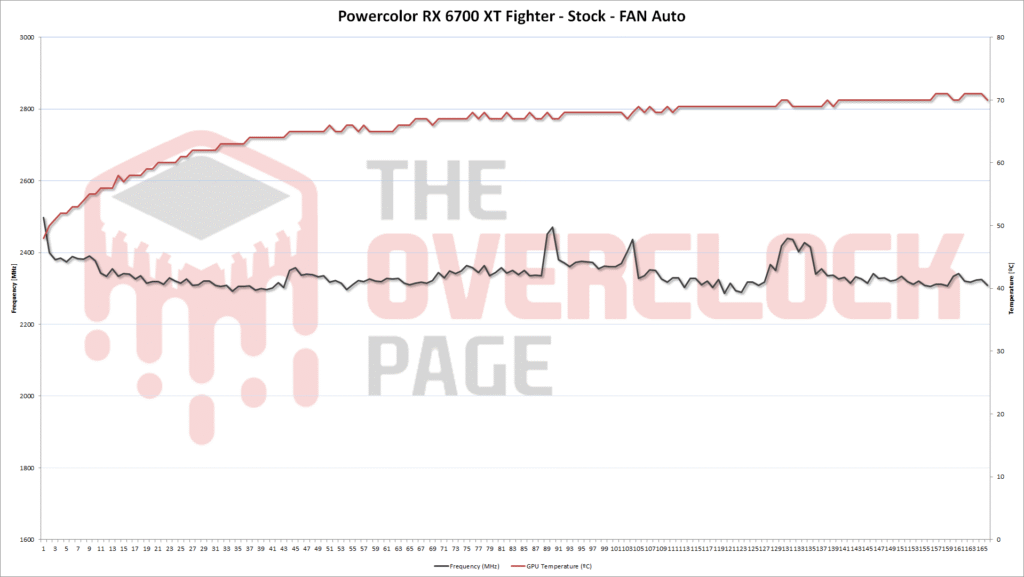
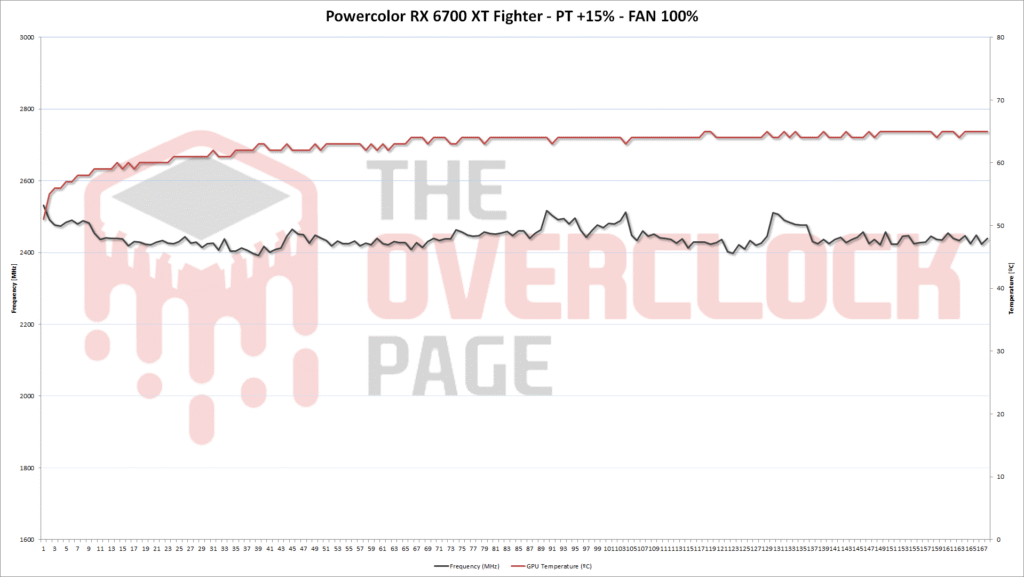
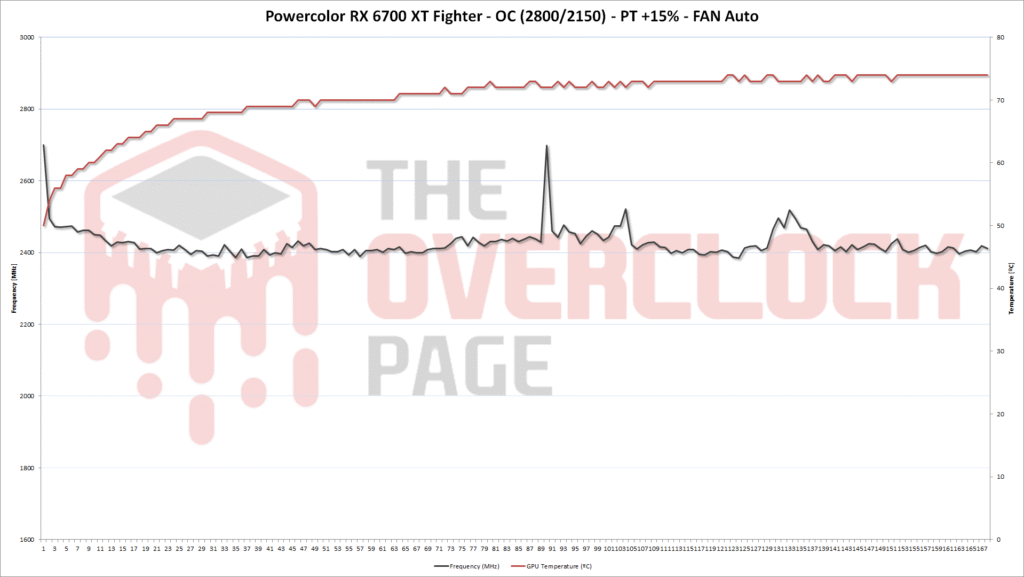
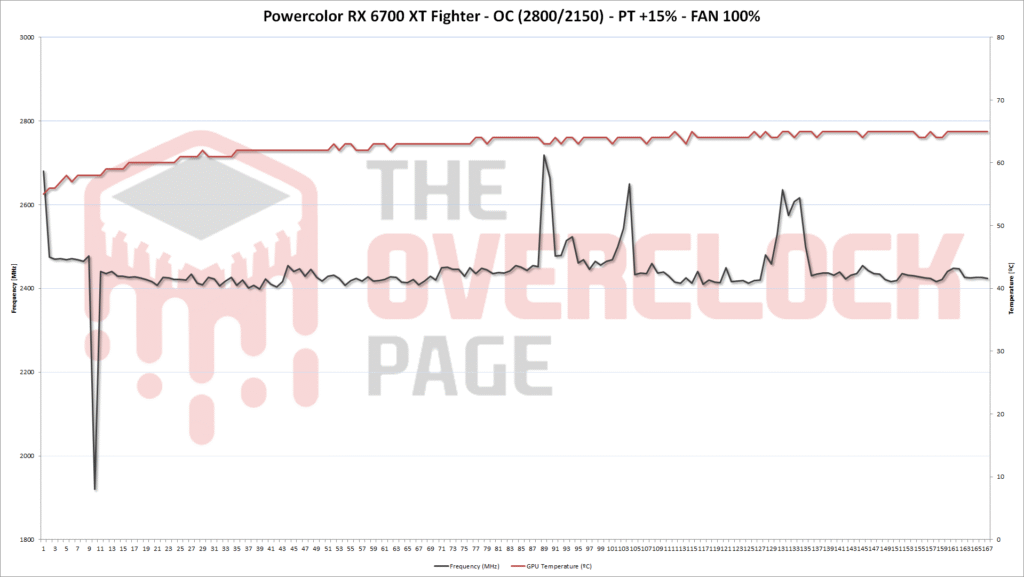
Despite AMD GPUs not having a visible “PerfCap” like NVIDIA, the limitations to GPU performance are virtually the same. In the case of the 6700 XT Fighter, it’s evident that the card is clearly constrained by its TDP, which, in this instance, is lower than the reference model. The standard TDP is 185W, and the maximum without resorting to MPT (More Power Tool) is 213W. Interestingly, the overclocked frequency, both with and without PT +15%, ended up being similar.
Based on tests with PT (Power Target) greater than 300W conducted in our livestream, this GPU still doesn’t reach 2800 MHz. The limiting factor becomes the GPU voltage, requiring a voltage surpassing 1.2V to achieve that level.
Power Consumption:
To measure the card’s power consumption, the Elmorlabs PMD with the PCI-E slot accessory was employed. This approach ensures a comprehensive measurement, as solely gauging the demand on the PCI-E connectors would lead to an unrealistic scenario, disregarding up to 75W of the total power consumption.
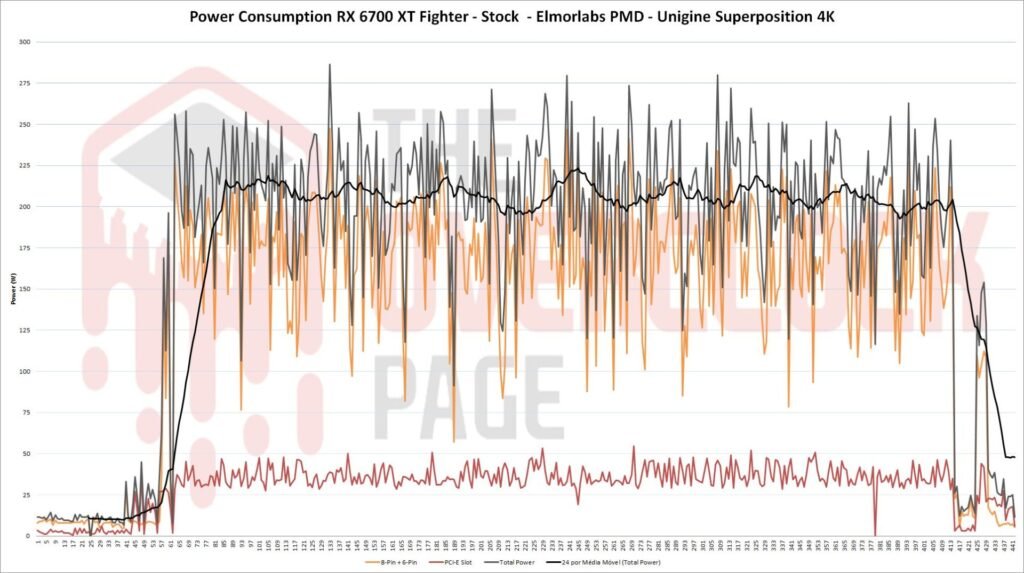
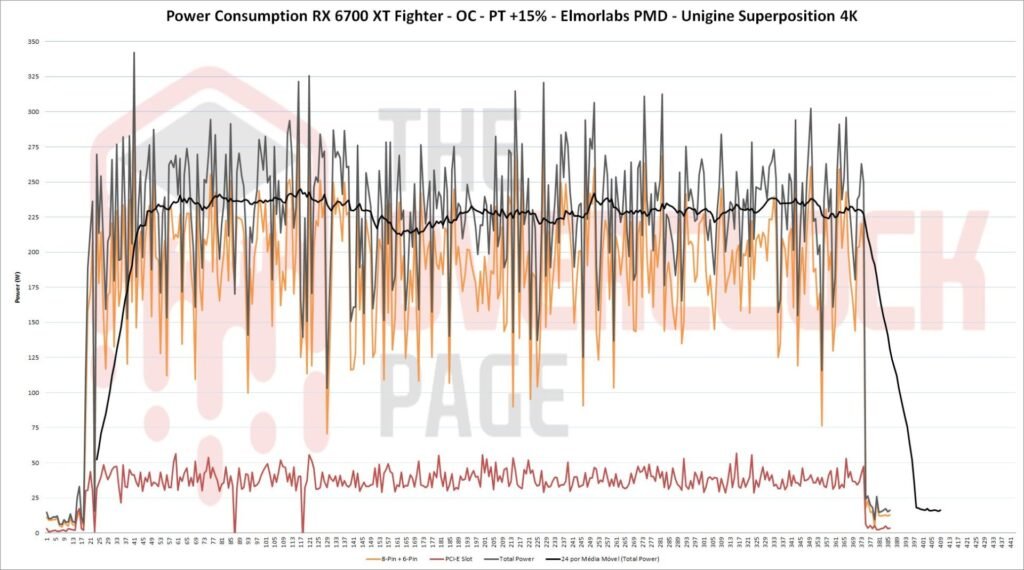
Unlike NVIDIA cards, where the reported power consumption refers to the entire card, in AMD cards, it specifically refers to the GPU. This was evident in our measurements with the PMD, where the 6700 XT, at stock settings, fluctuated between 200 and 225W. With overclocking, it surpassed this range on average.
Despite the relatively low consumption, it’s crucial to note that by unlocking the “Power Target” to +15%, numerous spikes above 300W were recorded. This highlights the importance of ensuring the power supply of the system is appropriately dimensioned.
Benchmarks:
Regarding the benchmarks, Cyberpunk 2077, Horizon: Zero Dawn, Shadow of the Tomb Raider (SOTTR), and UL Procyon were selected. In other words, a professional application and three games with support for the latest technologies.
- In Cyberpunk 2077, the latest version of the game was used, running at 1080p/1440p with the “High” preset and RT set to “medium.” The in-game benchmark tool was utilized to obtain these figures.
- For Horizon: Zero Dawn, the benchmark was conducted at 1080p/1440p with the settings on “Supreme Quality.”
- In the case of Shadow of the Tomb Raider (SOTTR), the in-game benchmark tool was employed at 1080p/1440p with the “High” preset and TAA.
- UL Procyon utilized the AI benchmark, incorporating a series of AI inference benchmarks.
Resultados:
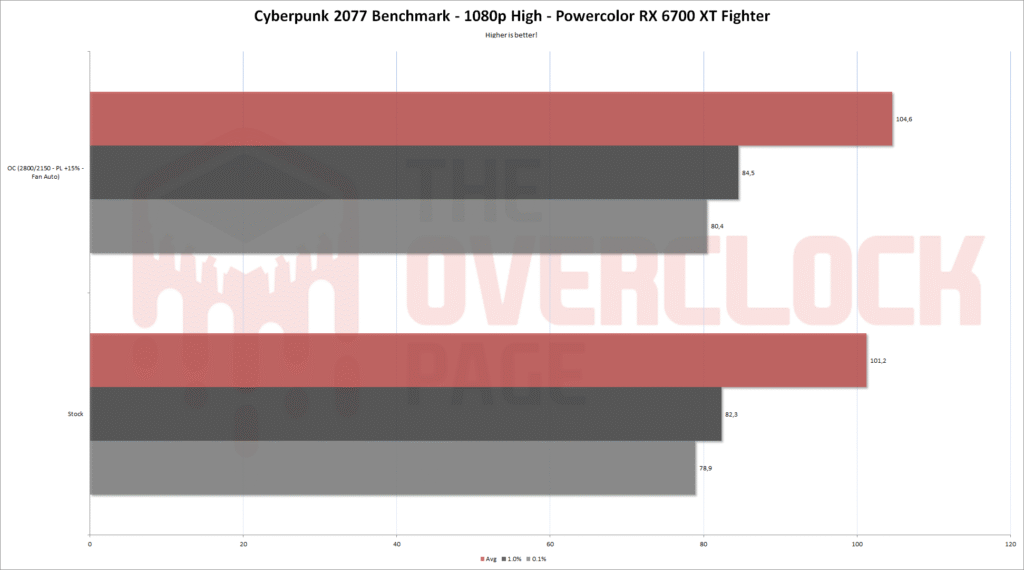
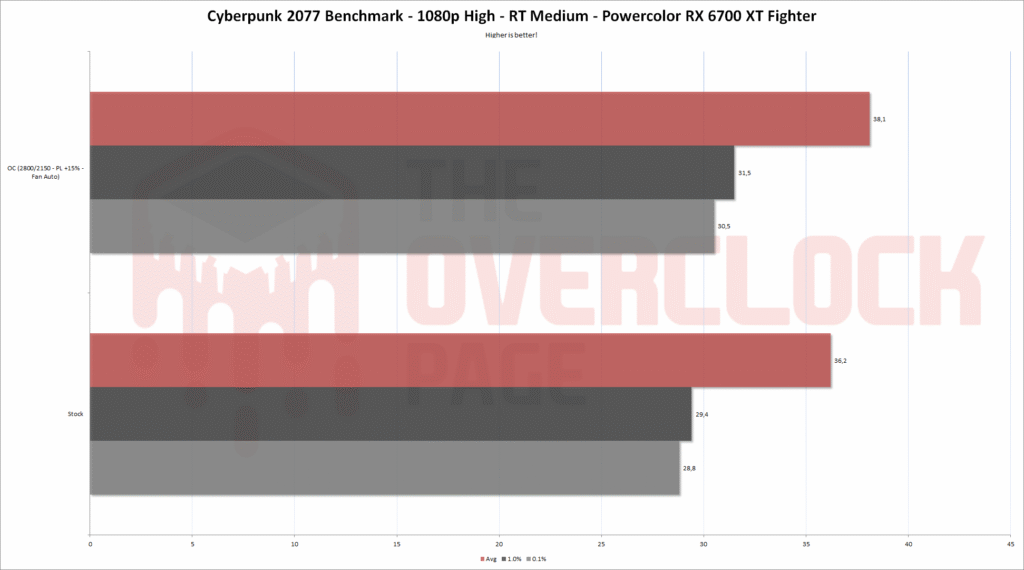
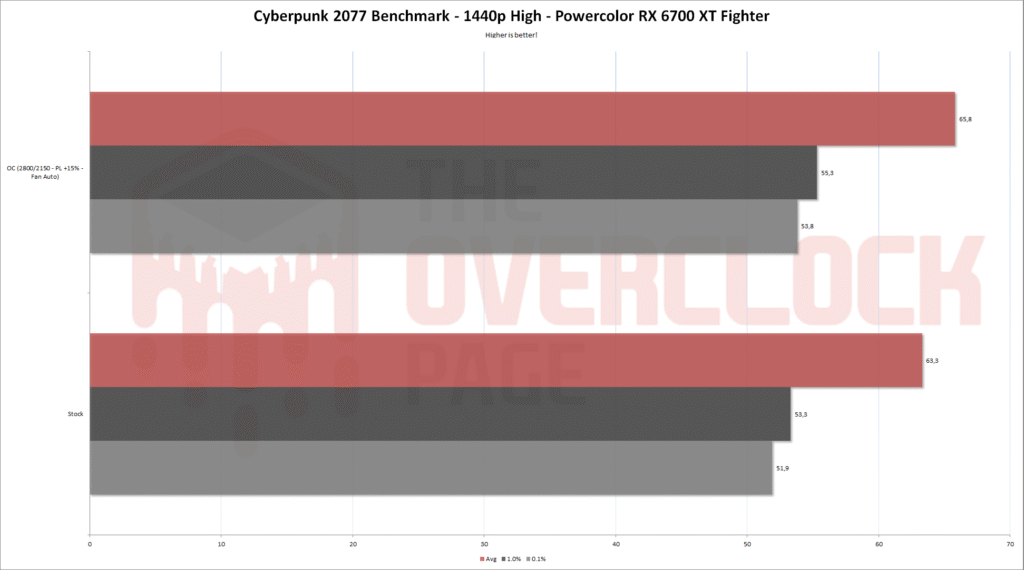
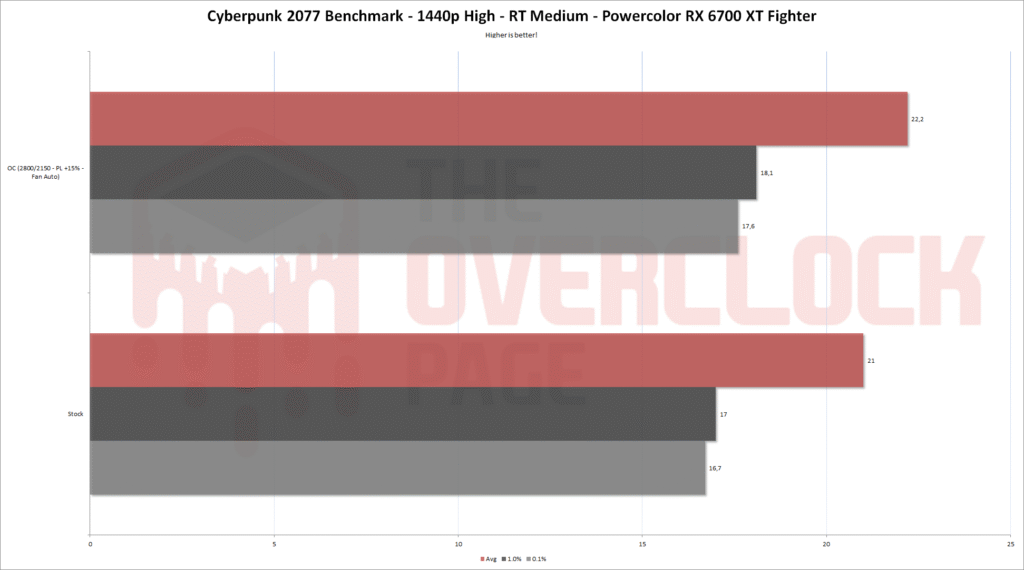
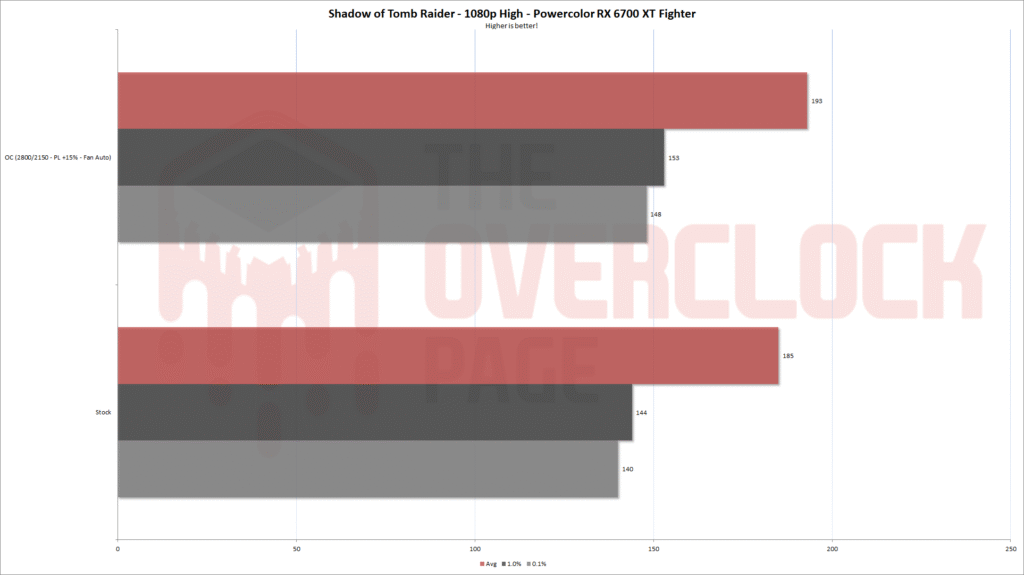
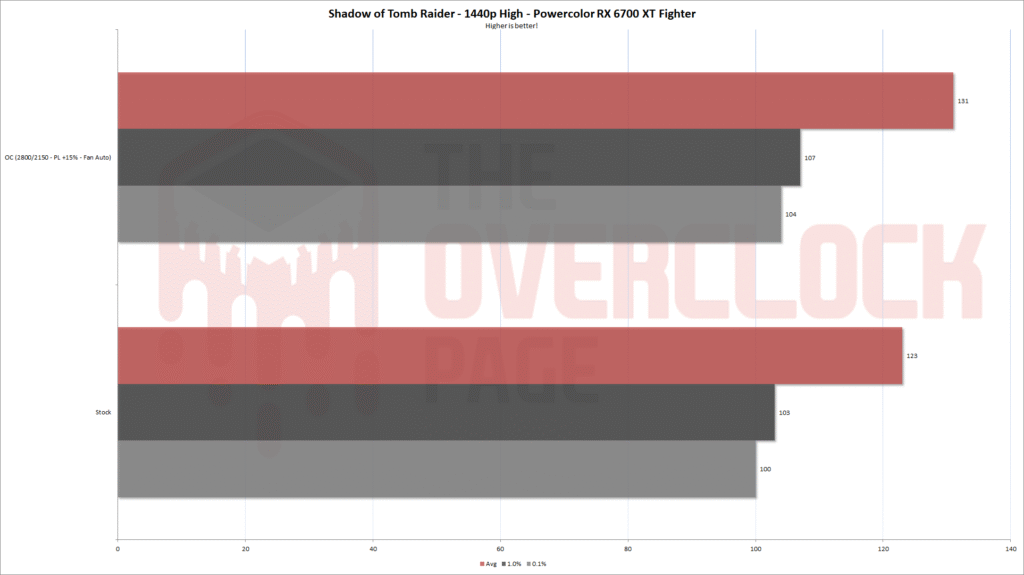

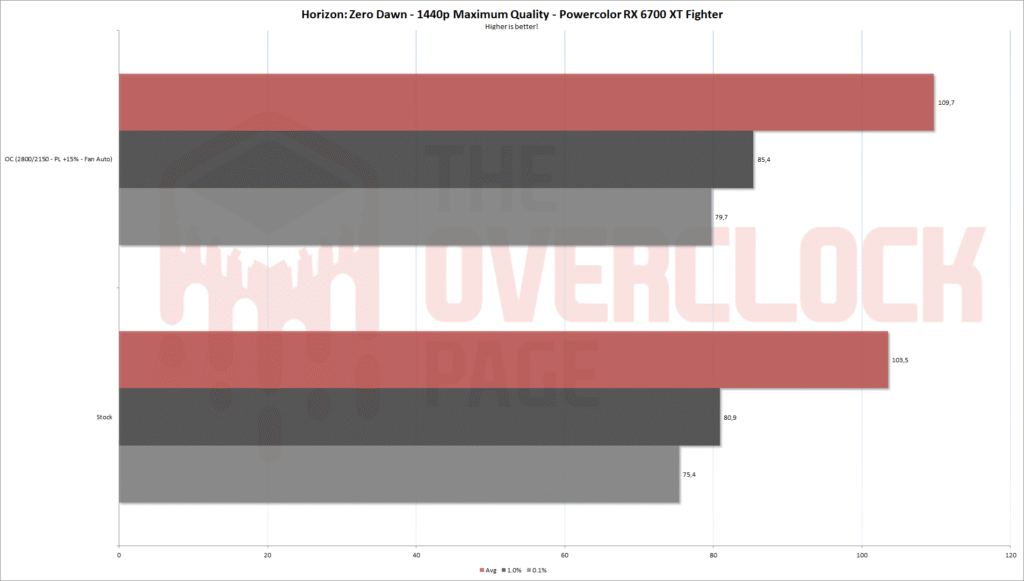
In terms of performance in the tested games, the 6700 XT Fighter demonstrated quite satisfactory results, even at 1440p, at least when Ray Tracing was not in play. However, the card experienced a performance hit when activating Ray Tracing in Cyberpunk 2077, requiring the user to either decrease details slightly or resort to FSR to make gameplay more feasible.
In UL Procyon with Windows ML, the RX 6700 XT achieved 291 points in FP32, which is considerably slower than the RTX 4060. Another drawback here is that the benchmark refused to run with FP16 precision, which is commonly used in Machine Learning—a problem not encountered with the NVIDIA card.
Competitive benchmarks:
Lastly, regarding the results obtained in competitive benchmarks, using the stock cooling system and without any physical modifications to the card but employing MPT to extend the maximum TDP beyond 300W, the RX 6700 XT achieved 14,496 points in 3DMark Time Spy. This is an excellent score when considering the inherent limitations.
If you’re interested in witnessing the overclocking session and also some brief tests in games with the 6700 XT Fighter without the TDP limit, you can check out the livestream below (in Brazilian Portuguese):
Conclusion:
Based on the information presented, several key points can be highlighted:
The Powercolor RX 6700 XT Fighter performed well in terms of GPU temperatures, reaching a maximum of 74°C on the GPU and 94°C on the Hot Spot in the worst-case scenario. The noise levels remained quite tolerable, marking a significant positive aspect for this card. This is particularly noteworthy as it stands out among models that don’t rely on massive triple-fan cooling systems, providing relief for those intending to build a compact yet powerful PC.
Regarding the VRM and memory temperatures, once again, positive results were observed, with the VRM and memory both peaking below 70°C. In the case of the memory, even the junction temperature remained below 80°C, well below the manufacturer’s specified limit of 95°C as mentioned in the datasheet.
Concerning the components utilized in the VRM, Powercolor opted for “powerstages” supplied by OnSemi. These highly integrated components offer greater efficiency compared to what an arrangement using discrete mosfets typically achieves. In this case, this combination proved to be more than sufficient for the card’s use, whether in stock configuration or during overclocking.
Regarding performance, the RX 6700 XT Fighter showcased commendable rasterization performance, handling tasks well even at 1440p. However, it faced challenges when activating Ray Tracing, necessitating the use of features like FSR in such cases.
Overclocking yielded relatively modest gains, typically staying below 5% when adhering to the maximum 213W limit of the default BIOS. Only occasionally did it reach 10% when unlocking the TDP via MPT. In other words, the performance implications due to the reduced default TDP are not substantial and can be easily compensated for if desired by the user.
In competitive benchmarks, achieving a respectable result in 3DMark Time Spy was possible by removing the TDP limit of the card, with room to go further by altering the GPU voltage beyond 1.2V. However, this wasn’t done as it requires modifications to the card for the installation of ElmorLabs EVC2.
Regarding the price, the Powercolor RX 6700 XT Fighter is available for around 330 USD, which is reasonable. However, within this price range, there are cards like the RX 6750 XT or RTX 3060 Ti, both available for the same price. The former offers slightly better performance, and the latter supports various exclusive NVIDIA features such as DLSS. With that said, the RX 6700 XT Fighter is recommended for those seeking a reasonably compact GPU with good performance and a reasonable value proposition. There might be slightly better alternatives available if size isn’t a limitation.

